2016 JEEP GRAND CHEROKEE check engine
[x] Cancel search: check enginePage 646 of 723
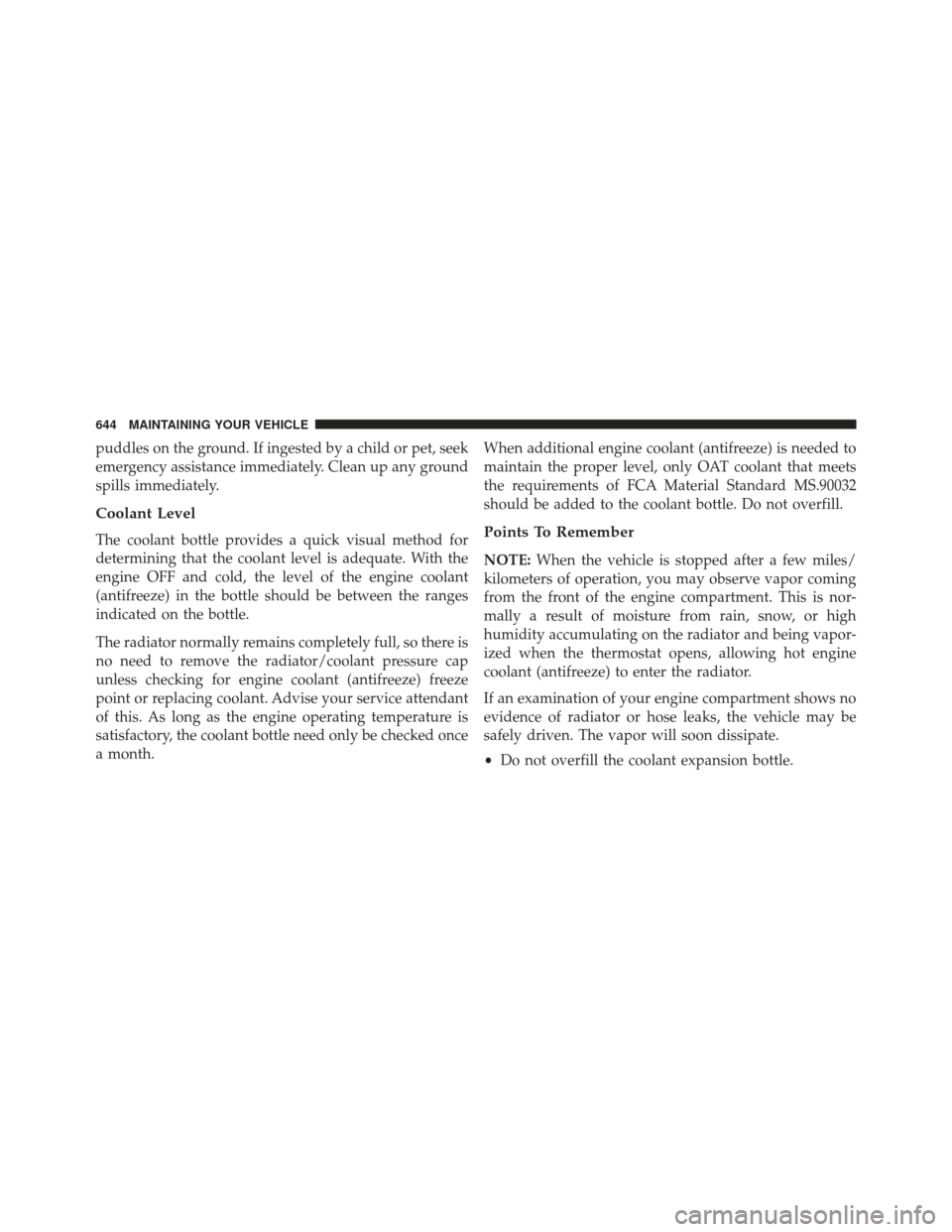
puddles on the ground. If ingested by a child or pet, seek
emergency assistance immediately. Clean up any ground
spills immediately.
Coolant Level
The coolant bottle provides a quick visual method for
determining that the coolant level is adequate. With the
engine OFF and cold, the level of the engine coolant
(antifreeze) in the bottle should be between the ranges
indicated on the bottle.
The radiator normally remains completely full, so there is
no need to remove the radiator/coolant pressure cap
unless checking for engine coolant (antifreeze) freeze
point or replacing coolant. Advise your service attendant
of this. As long as the engine operating temperature is
satisfactory, the coolant bottle need only be checked once
a month.When additional engine coolant (antifreeze) is needed to
maintain the proper level, only OAT coolant that meets
the requirements of FCA Material Standard MS.90032
should be added to the coolant bottle. Do not overfill.Points To Remember
NOTE:
When the vehicle is stopped after a few miles/
kilometers of operation, you may observe vapor coming
from the front of the engine compartment. This is nor-
mally a result of moisture from rain, snow, or high
humidity accumulating on the radiator and being vapor-
ized when the thermostat opens, allowing hot engine
coolant (antifreeze) to enter the radiator.
If an examination of your engine compartment shows no
evidence of radiator or hose leaks, the vehicle may be
safely driven. The vapor will soon dissipate.
• Do not overfill the coolant expansion bottle.
644 MAINTAINING YOUR VEHICLE
Page 647 of 723
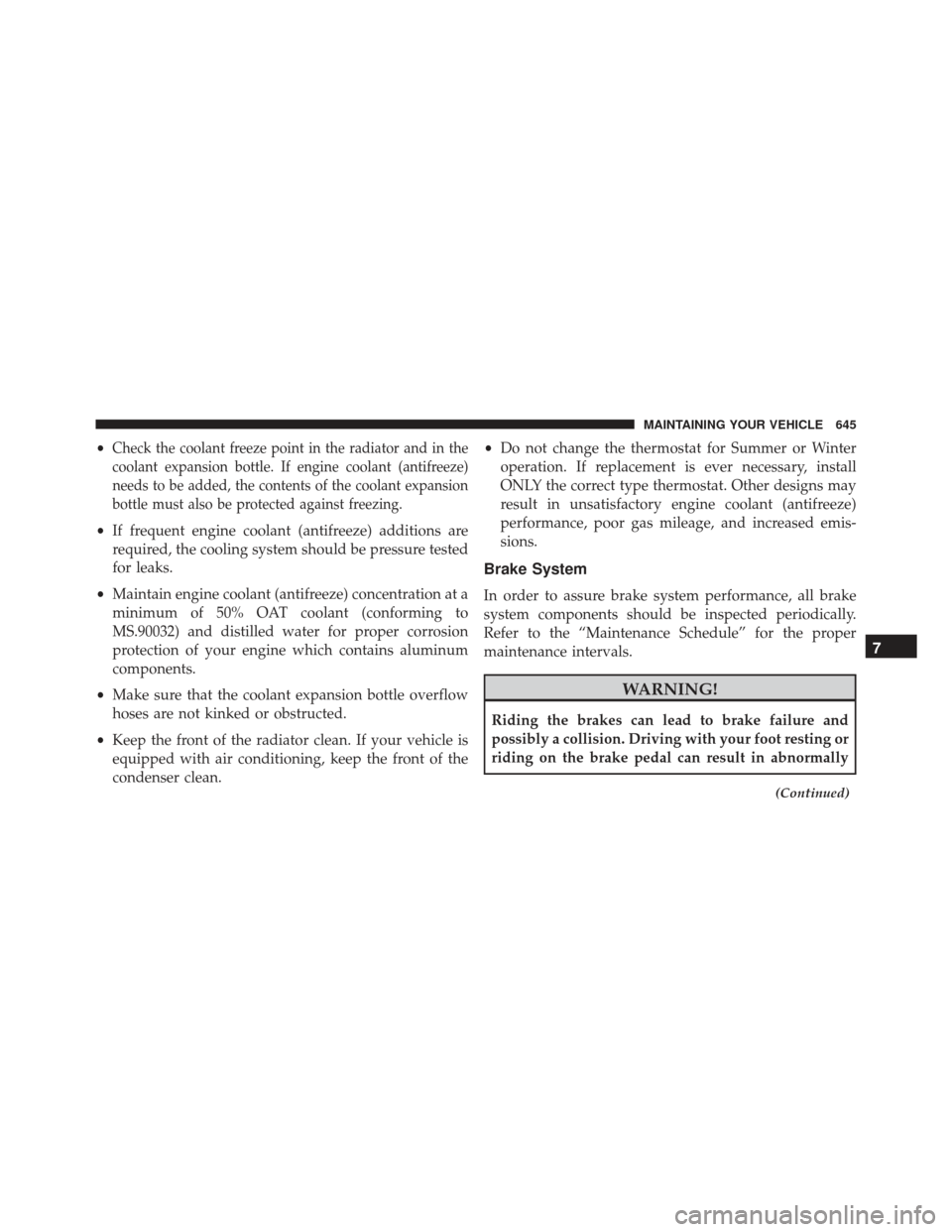
•Check the coolant freeze point in the radiator and in the
coolant expansion bottle. If engine coolant (antifreeze)
needs to be added, the contents of the coolant expansion
bottle must also be protected against freezing.
• If frequent engine coolant (antifreeze) additions are
required, the cooling system should be pressure tested
for leaks.
• Maintain engine coolant (antifreeze) concentration at a
minimum of 50% OAT coolant (conforming to
MS.90032) and distilled water for proper corrosion
protection of your engine which contains aluminum
components.
• Make sure that the coolant expansion bottle overflow
hoses are not kinked or obstructed.
• Keep the front of the radiator clean. If your vehicle is
equipped with air conditioning, keep the front of the
condenser clean. •
Do not change the thermostat for Summer or Winter
operation. If replacement is ever necessary, install
ONLY the correct type thermostat. Other designs may
result in unsatisfactory engine coolant (antifreeze)
performance, poor gas mileage, and increased emis-
sions.
Brake System
In order to assure brake system performance, all brake
system components should be inspected periodically.
Refer to the “Maintenance Schedule” for the proper
maintenance intervals.
WARNING!
Riding the brakes can lead to brake failure and
possibly a collision. Driving with your foot resting or
riding on the brake pedal can result in abnormally
(Continued)
7
MAINTAINING YOUR VEHICLE 645
Page 649 of 723
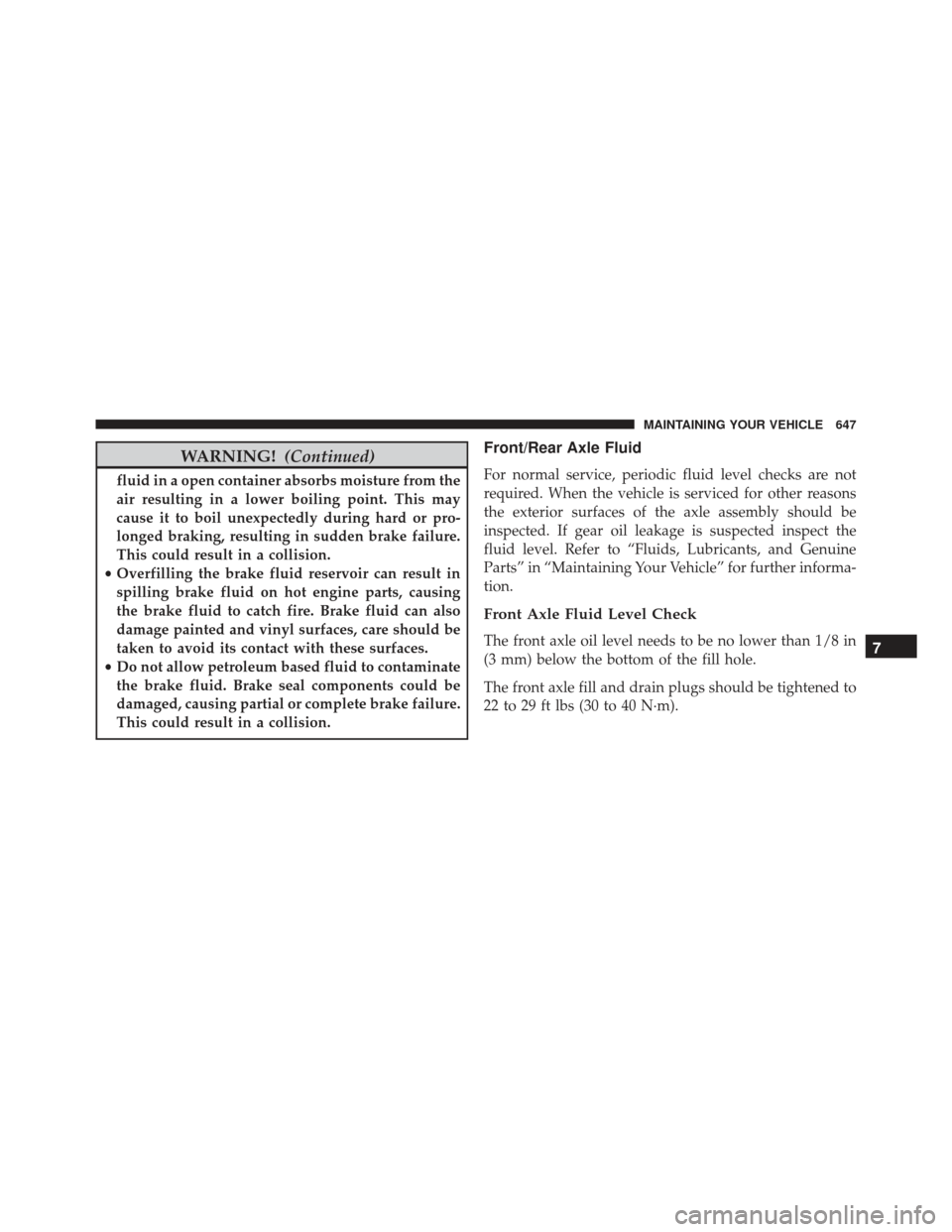
WARNING!(Continued)
fluid in a open container absorbs moisture from the
air resulting in a lower boiling point. This may
cause it to boil unexpectedly during hard or pro-
longed braking, resulting in sudden brake failure.
This could result in a collision.
• Overfilling the brake fluid reservoir can result in
spilling brake fluid on hot engine parts, causing
the brake fluid to catch fire. Brake fluid can also
damage painted and vinyl surfaces, care should be
taken to avoid its contact with these surfaces.
• Do not allow petroleum based fluid to contaminate
the brake fluid. Brake seal components could be
damaged, causing partial or complete brake failure.
This could result in a collision.
Front/Rear Axle Fluid
For normal service, periodic fluid level checks are not
required. When the vehicle is serviced for other reasons
the exterior surfaces of the axle assembly should be
inspected. If gear oil leakage is suspected inspect the
fluid level. Refer to “Fluids, Lubricants, and Genuine
Parts” in “Maintaining Your Vehicle” for further informa-
tion.
Front Axle Fluid Level Check
The front axle oil level needs to be no lower than 1/8 in
(3 mm) below the bottom of the fill hole.
The front axle fill and drain plugs should be tightened to
22 to 29 ft lbs (30 to 40 N·m).7
MAINTAINING YOUR VEHICLE 647
Page 652 of 723
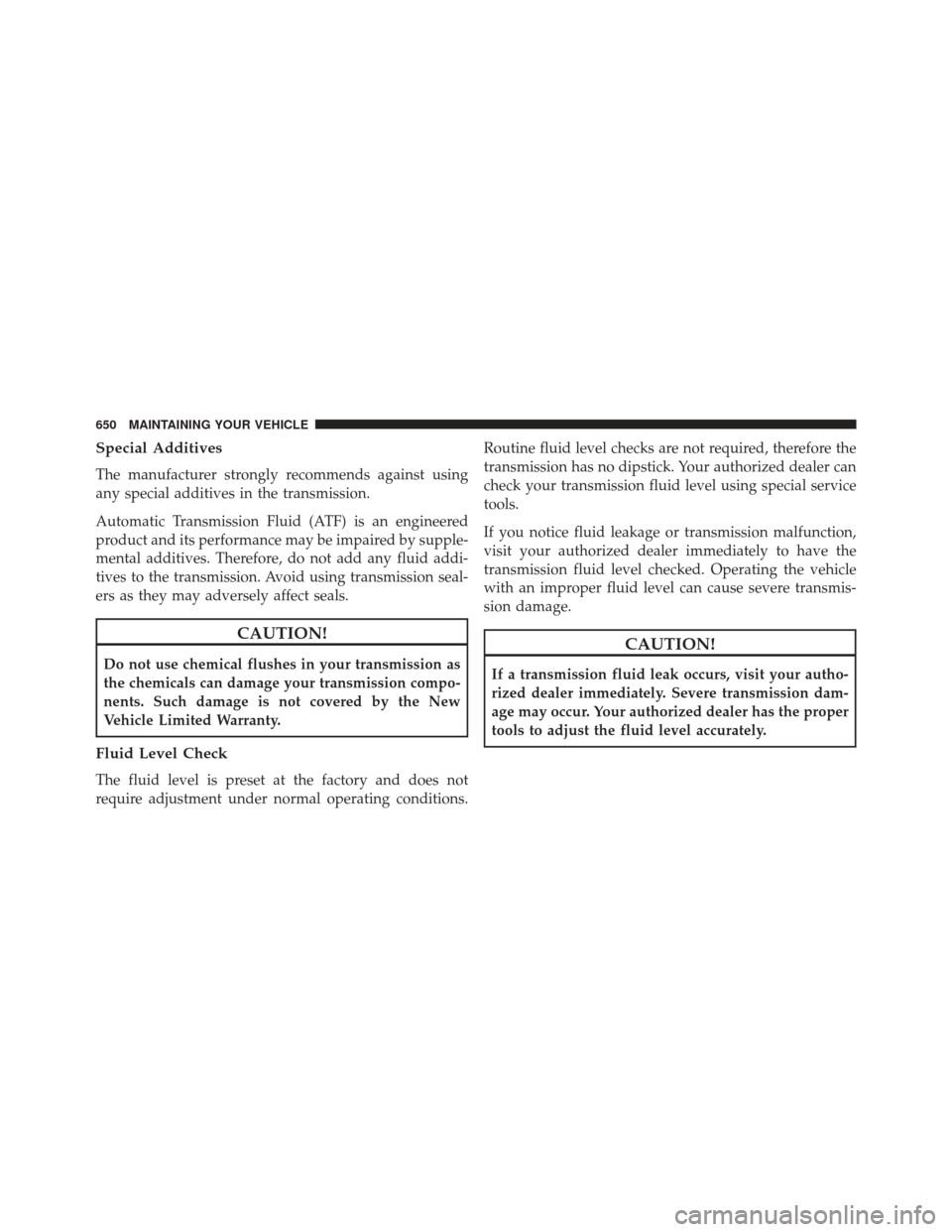
Special Additives
The manufacturer strongly recommends against using
any special additives in the transmission.
Automatic Transmission Fluid (ATF) is an engineered
product and its performance may be impaired by supple-
mental additives. Therefore, do not add any fluid addi-
tives to the transmission. Avoid using transmission seal-
ers as they may adversely affect seals.
CAUTION!
Do not use chemical flushes in your transmission as
the chemicals can damage your transmission compo-
nents. Such damage is not covered by the New
Vehicle Limited Warranty.
Fluid Level Check
The fluid level is preset at the factory and does not
require adjustment under normal operating conditions.Routine fluid level checks are not required, therefore the
transmission has no dipstick. Your authorized dealer can
check your transmission fluid level using special service
tools.
If you notice fluid leakage or transmission malfunction,
visit your authorized dealer immediately to have the
transmission fluid level checked. Operating the vehicle
with an improper fluid level can cause severe transmis-
sion damage.
CAUTION!
If a transmission fluid leak occurs, visit your autho-
rized dealer immediately. Severe transmission dam-
age may occur. Your authorized dealer has the proper
tools to adjust the fluid level accurately.
650 MAINTAINING YOUR VEHICLE
Page 683 of 723
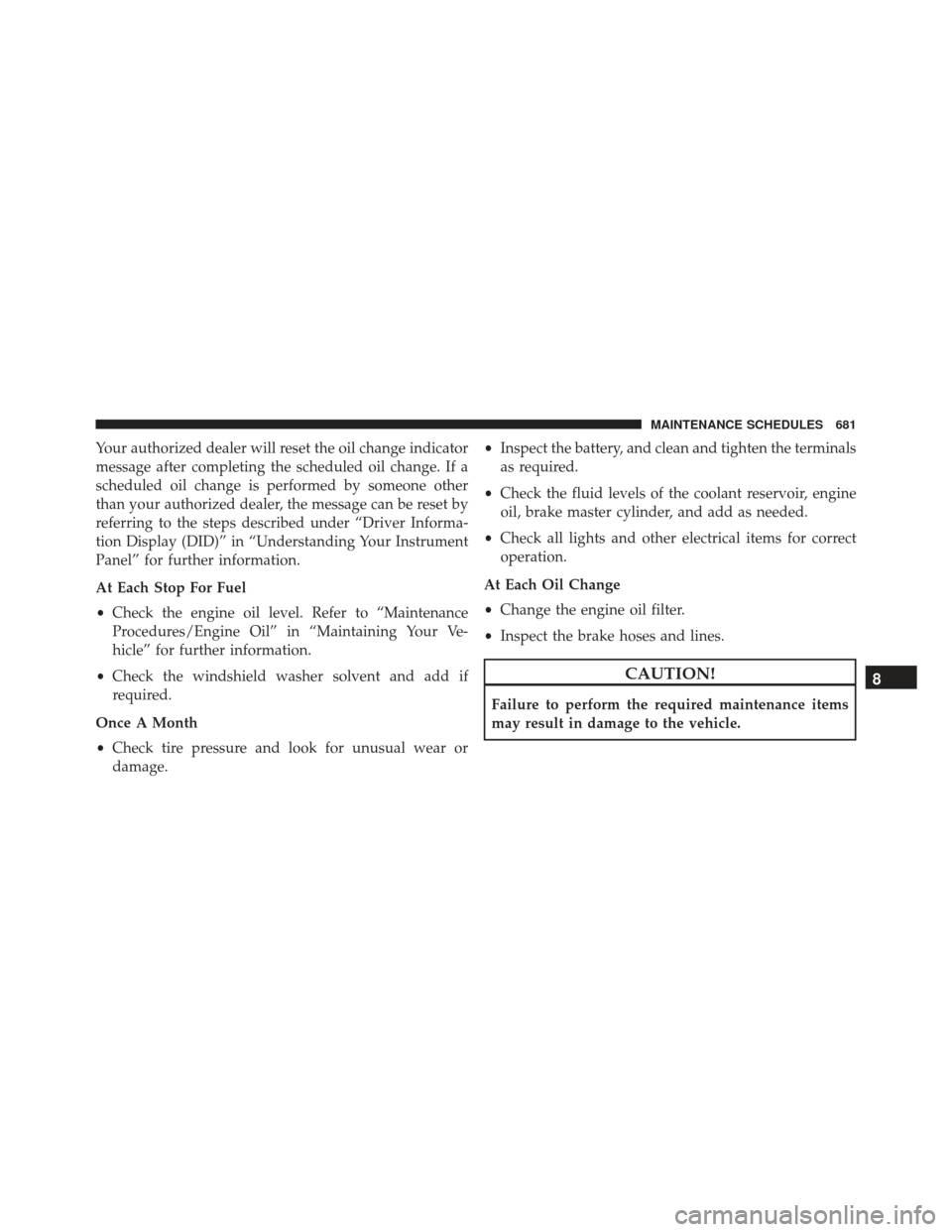
Your authorized dealer will reset the oil change indicator
message after completing the scheduled oil change. If a
scheduled oil change is performed by someone other
than your authorized dealer, the message can be reset by
referring to the steps described under “Driver Informa-
tion Display (DID)” in “Understanding Your Instrument
Panel” for further information.
At Each Stop For Fuel
•Check the engine oil level. Refer to “Maintenance
Procedures/Engine Oil” in “Maintaining Your Ve-
hicle” for further information.
• Check the windshield washer solvent and add if
required.
Once A Month
• Check tire pressure and look for unusual wear or
damage. •
Inspect the battery, and clean and tighten the terminals
as required.
• Check the fluid levels of the coolant reservoir, engine
oil, brake master cylinder, and add as needed.
• Check all lights and other electrical items for correct
operation.
At Each Oil Change
• Change the engine oil filter.
• Inspect the brake hoses and lines.
CAUTION!
Failure to perform the required maintenance items
may result in damage to the vehicle.
8
MAINTENANCE SCHEDULES 681
Page 703 of 723
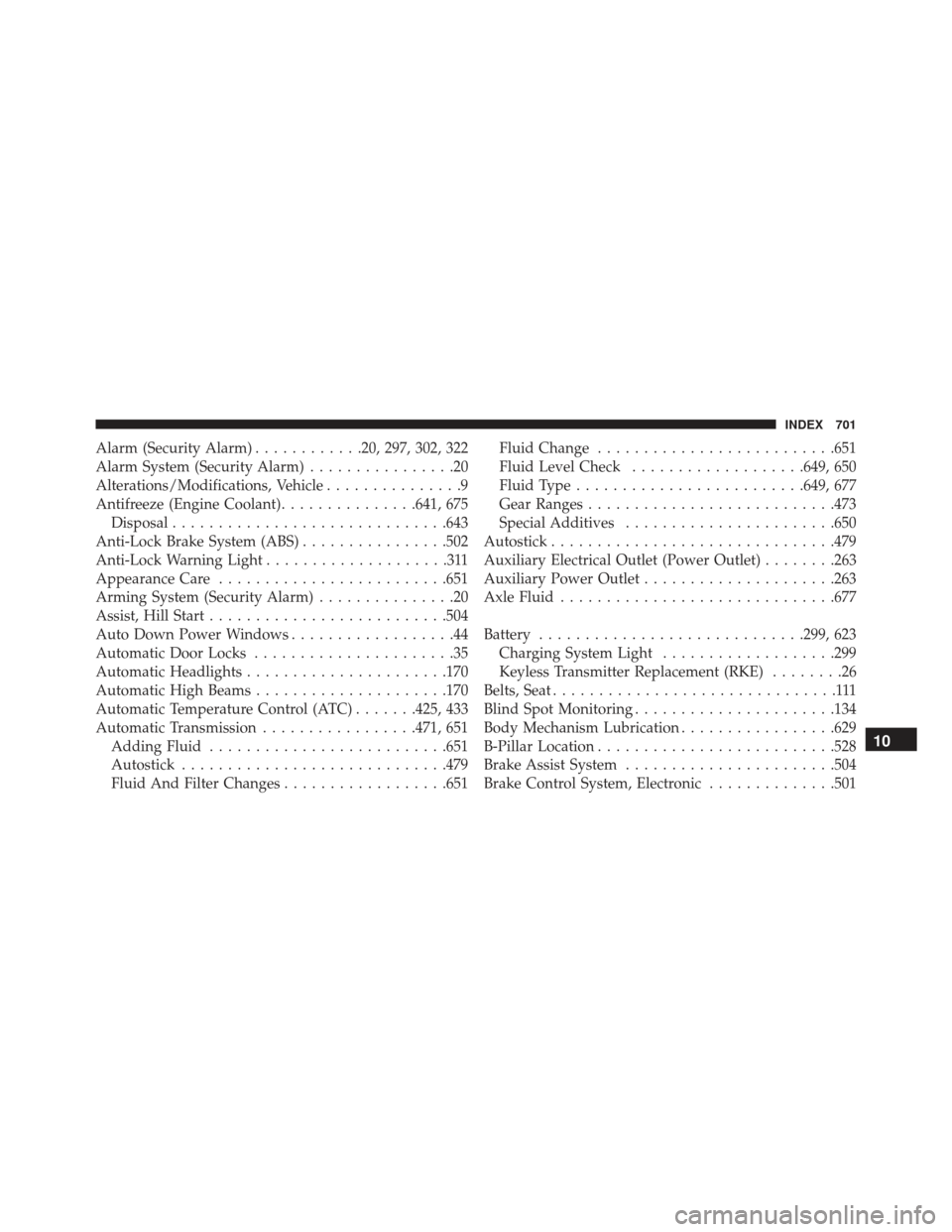
Alarm (Security Alarm)............20, 297, 302, 322
Alarm System (Security Alarm) ................20
Alterations/Modifications, Vehicle ...............9
Antifreeze (Engine Coolant) ...............641, 675
Disposal ............................. .643
Anti-Lock Brake System (ABS) ................502
Anti-Lock Warning Light ....................311
Appearance Care ........................ .651
Arming System (Security Alarm) ...............20
Assist, Hill Start ......................... .504
Auto Down Power Windows ..................44
Automatic Door Locks ......................35
Automatic Headlights ..................... .170
Automatic High Beams .....................170
Automatic Temperature Control (ATC) .......425, 433
Automatic Transmission .................471, 651
Adding Fluid ......................... .651
Autostick ............................ .479
Fluid And Filter Changes ..................651 Fluid Change
......................... .651
Fluid Level Check ...................649, 650
Fluid Type ........................ .649, 677
Gear Ranges .......................... .473
Special Additives ...................... .650
Autostick .............................. .479
Auxiliary Electrical Outlet (Power Outlet) ........263
Auxiliary Power Outlet .....................263
Axle Fluid ............................. .677
Battery ............................ .299, 623
Charging System Light ...................299
Keyless Transmitter Replacement (RKE) ........26
Belts, Seat ...............................111
Blind Spot Monitoring ..................... .134
Body Mechanism Lubrication .................629
B-Pillar Location ......................... .528
Brake Assist System ...................... .504
Brake Control System, Electronic ..............501
10
INDEX 701
Page 704 of 723

Brake Fluid......................... .646, 677
Brake System ........................ .500, 645
Anti-Lock (ABS) ....................... .500
Fluid Check .......................... .646
Master Cylinder ....................... .646
Parking ............................. .498
Warning Light ........................ .295
Brake/Transmission Interlock .................470
Braking ............................... .335
SRT ................................ .335
Braking Distance ......................... .335
SRT ................................ .335
Bulb Replacement ..................... .667, 669
Bulbs, Light .............................113
Camera, Rear ........................... .246
Capacities, Fluid ......................... .675
Caps, Filler Oil (Engine) ....................... .615, 617Radiator (Coolant Pressure)
................643
Carbon Monoxide Warning ...............110,559
Cargo Area Cover ........................ .276
Cargo Area Features ...................... .273
Cargo Compartment ...................... .273
Light ............................... .274
Cargo Light ............................ .274
Cargo Tie-Downs ........................ .277
Car Washes ............................ .652
Cellular Phone .......................... .424
Center High Mounted Stop Light ..............674
Certification Label ........................ .563
Chains, Tire ............................ .545
Chart, Tire Sizing ........................ .523
Check Engine Light (Malfunction Indicator Light) . .611
Checking Your Vehicle For Safety ..............109
Checks, Safety .......................... .109
Child Restraint ............................83
702 INDEX
Page 707 of 723
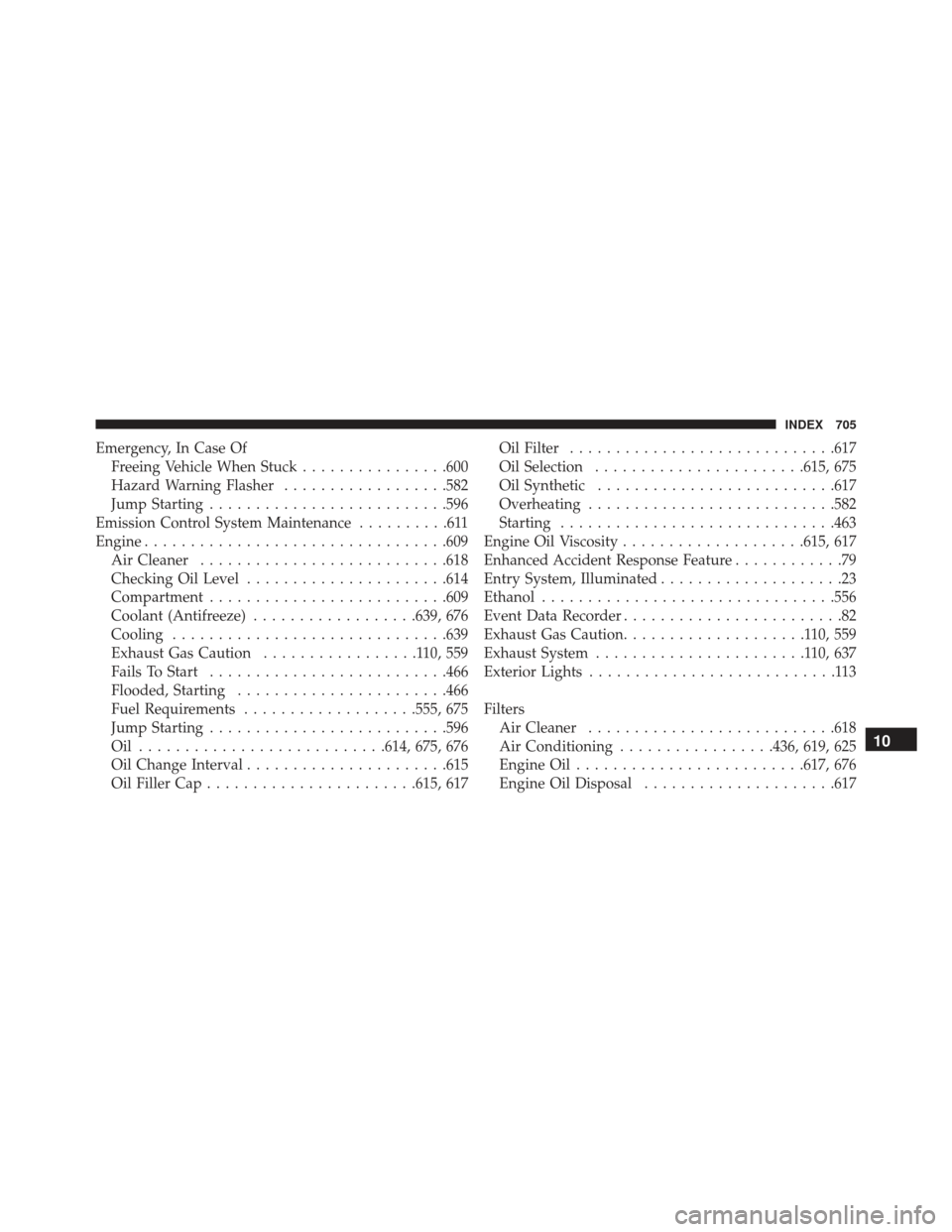
Emergency, In Case OfFreeing Vehicle When Stuck ................600
Hazard Warning Flasher ..................582
Jump Starting ......................... .596
Emission Control System Maintenance ..........611
Engine ................................ .609
Air Cleaner .......................... .618
Checking Oil Level ..................... .614
Compartment ......................... .609
Coolant (Antifreeze) ..................639, 676
Cooling ............................. .639
Exhaust Gas Caution .................110,559
Fails To Start ......................... .466
Flooded, Starting ...................... .466
Fuel Requirements ...................555, 675
Jump Starting ......................... .596
Oil .......................... .614, 675, 676
Oil Change Interval ..................... .615
Oil Filler Cap ...................... .615, 617Oil Filter
............................ .617
Oil Selection ...................... .615, 675
Oil Synthetic ......................... .617
Overheating .......................... .582
Starting ............................. .463
Engine Oil Viscosity ....................615, 617
Enhanced Accident Response Feature ............79
Entry System, Illuminated ....................23
Ethanol ............................... .556
Event Data Recorder ........................82
Exhaust Gas Caution ....................110,559
Exhaust System .......................110,637
Exterior Lights ...........................113
Filters Air Cleaner .......................... .618
Air Conditioning .................436, 619, 625
Engine Oil ........................ .617, 676
Engine Oil Disposal .....................617
10
INDEX 705